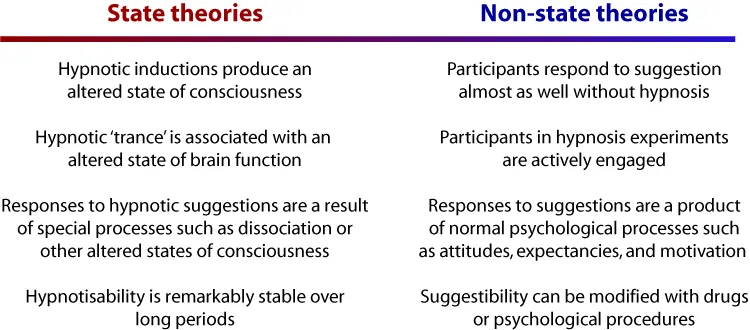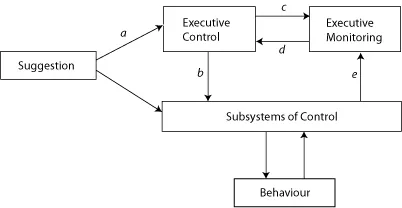Hypnosis Models
Here’s a digest of ramblings about different models of hypnosis. You’d likely do better reading the page over on hypnosisandsuggestion.org. This is supposed to a more digestible overview for folks coming from the usual state-based (trance) understanding of hypnosis. In case, I’m not done writing this and cleaning it up.
Have a geocities gif as a token of my commitment to never complete this page.

Overall State vs Non-State
Section titled “Overall State vs Non-State”A weakness in state theory is that it overlooks the fact that a positive view and framing of hypnosis can improve response. According to research, the effect of an induction is modest compared to things like “motivation, responsiveness to targeted suggestions in non-hypnotic contexts, fantasy-proneness, or absorption capacities.” In addition, hypnotic suggestibility is much stronger in a ‘hypnotic context.’
In non-state theory, ‘hypnotizability’ does not exist. State theories are only plausible through measurement. Measurement in and of itself does not infer usefulness or even existence of the thing you’re trying to measure. Using only what you can measure in a complex interaction may be unwise. From conversations with others in a recreational setting, group and file sessions seem less effective, hinting at a social element.
Hypnotic response is different between person to person, and is somewhat stable - a takeaway that non-state theory can overlook. EG: “…the effects of inductions on decreasing the activity of the medial prefrontal cortex were observed in individuals with high hypnotic suggestibility in contrast to those with low hypnotic suggestibility.”
Theroretical Perspectives
Section titled “Theroretical Perspectives” (From https://hypnosisandsuggestion.org/states-of-consciousness.html.)
(From https://hypnosisandsuggestion.org/states-of-consciousness.html.)
State theories (e.g., Ericksonian, conditioning, psycho-analytic)
Section titled “State theories (e.g., Ericksonian, conditioning, psycho-analytic)”Describes hypnosis as a distinct state, created through induction and presents itself through heightened responses (subjective, behavioral, and neurophysiological.) The hypnotizability of a person is a generally stable trait.
Hilgard’s Neodissocation Theory
Section titled “Hilgard’s Neodissocation Theory”Suggestions happen behind an ‘amnesic barrier.’
Overview:
- Splits the Executive Control System (ECS) into associated and dissociated parts, through an ‘amnesic barrier’
- Half the ECS responds normally, the other half is ‘behind’ the barrier, creating hypnotic responses, that can’t be observed, only the results
- Inspired by controversial ‘hidden observer’ experiments
Gruzelier’s Neurophysiological Theory
Section titled “Gruzelier’s Neurophysiological Theory”Highs have better and more flexible executive control. The hypnotist helps exhaust the subject’s frontal abilities, where after a certain point they can take the keys to driving the experience.
- Subject focuses on hypnotist and controls attention. (Left-sided fronto-limbic brain regions.)
- Subject lets go and gives control to the hypnotist. (Reduction in left frontal activity.)
- Increase in right-sided temporo-posterior systems - engaged in passive imagery.
This theory is special since it can actually be measured.
https://cud-narodzin.pl/wp-content/uploads/2015/09/Gruzelier-CH-1998-Working-model.pdf
Dissociative theories (dissociative experience, dissociative control)
Section titled “Dissociative theories (dissociative experience, dissociative control)”Highlight the role of dissociation and dissociative tendencies in hypnotic responding.
- Dissociative theories suggest this works on impaired self-monitoring
- Highs respond voluntarily, but are dissociated from monitoring
- Dissociative theorists suggest there’s a distinctly hypnotic pain control mechanism
In a study, chronically dissociated high responders were compared to people that have a normal (low) level of dissociation. This isn’t explicitly presented as a unique theory, but there’s a chance that some people have control over their level of dissociation.
Levels of dissociative experiences were literally measured with the Dissociative Experiences Scale II. http://traumadissociation.com/des https://youtu.be/2hYna8LR2Y4?t=3762 https://www.sciencedirect.com/science/article/abs/pii/S1053810012000748
Dissociated control theory - 1994 - The components that initiate and take action are somehow dissociated from each-other
Non-state theories
Section titled “Non-state theories”Subjects as active participants and observers where there’s a misattribution in their volition to take action. They still decide to do things. They are not ‘faking,’ but this is just the underlying function.
Socio-cognitive theories (e.g., response set and discrepancy attribution theories)
Section titled “Socio-cognitive theories (e.g., response set and discrepancy attribution theories)”A goal-oriented, non-automatic, active process, built on expectation and rapport. Social-cognitive (response set theory) points at attitudes/beliefs/demands that impair self monitoring. Remarkably,
TX Barber, a prominent socio-cognitive theorist was still able to create new and effective developments in pain research. The pain suggestions work with our without hypnosis, only affecting how automatic it feels.
TX Barber: “With or without a preceding hypnotic procedure, experimental subjects obtain relatively high scores on hypnotic susceptibility or suggestibility scales… when they have positive attitudes toward the hypnotic or suggestive situation, positive motivations to experience hypnosis (or the suggested effects), and positive expectancies that they can experience what is suggested… they think and imagine along with the suggestions while letting go of interfering thoughts.”
Socio-cognitive Theory - 1986 Spanos - roles/beliefs/expectations around hypnosis shape phenomena. There is nothing ‘special’ about hypnosis.
Response expectancy Theory - 1985 - Expectations of an interaction can generate involuntary (or unwitting) responses. Therefore misattribution occurs.
Relational theories
Section titled “Relational theories”Focus on the relationship, rapport, hypnotic interactions (how convincing is the interaction,) oxytocin, and attachment style.
Integrative Fence-sitters
Section titled “Integrative Fence-sitters”Focus on top-down metacognitive processes, and their control on things that can be hypnotic.
Cold control theory:
Section titled “Cold control theory:”https://www.youtube.com/watch?v=2hYna8LR2Y4 The opposite of meditation. Where instead of monitoring your metacognition to get the correct response, you intentionally try to allow the ‘incorrect’ response to happen. It draws the distinction between being in a mental state and being aware of being in a mental state. Hypnotic response occurs when we’re unaware of forming the intention to make something happen.\
Interestingly:
- Transcranial Stimulation (zapping the dorsolateral prefrontal cortex) temporarily improves hypnotizability, suggesting interrupting higher order thoughts (HOTs) destroys the attached intention
- Alcohol also improves hypnotizability - and one of the first things alcohol slaps is the DLPFC
- ‘Ego depletion’ (wearing your subject out) had a negative effect on hypnotizability
- Regular meditators have an overall more difficult time being hypnotized, statistically
- Cold control suggests that you do not gain or lose abilities through hypnosis, the feeling of automaticity just changes
- “They form the intention to ignore the number four, and that intention can be unconscious…” Executive inhibition can be a part of cold control, just as modifying a habit, or ignoring pain.
- It’s even more effective using a non-hypnotic suggestion to say the text is meaningless in order to fight the Stroop effect
What are HOTS?
Section titled “What are HOTS?”- 1st - The object in front of me is black (possibly missed in interoception in some cases)
- “Lift the left arm”
- 2nd - I see that the object in front of me is black (likely aware, but not always)
- “I am intending to lift my left arm”
- 3rd - I am aware that I’m seeing an object that is black (aware by requirement)
- “I am aware that I am intending to lift my left arm” http://users.sussex.ac.uk/~dienes/cold%20control%20chapter.pdf
Brown & Oakley’s Integrative Cognitive Theory
Section titled “Brown & Oakley’s Integrative Cognitive Theory”Integrates dissociated control and response set theories. Preventing high level attention may allow dissociation, or just to some degree a less voluntary response.
Dissociated Control Theory (DCT)
Section titled “Dissociated Control Theory (DCT)”Focuses on highly hypnotizable individuals.
- The supervisory attentional system (SAS) dissociates from the contention scheduling system (CS)
- Since the SAS is partially disabled, the ‘lower-level’ CS is used
- The hypnotist can use the CS to directly influence their experience

Woody & Sadler (2008) presented an integrative model of dissociative theories of hypnosis, shown above. and their chapter provides a comprehensive overview of this topic. In their model, a theory of dissociated experience involves the weakening of path c, and possibly of path e. A theory of dissociated control involves the weakening of path b, and possibly of path a. A theory of second-order dissociated control involves the weakening of path d.
References
Section titled “References”https://www.sciencedirect.com/science/article/pii/S174438812300107X https://www.sciencedirect.com/science/article/pii/S1744388123000579?via%3Dihub#sec6 Tranceworks (minimal) https://hypnosisandsuggestion.org/theories-of-hypnosis.html - https://hypnosisandsuggestion.org/states-of-consciousness.html #todo https://www.sciencedirect.com/science/article/pii/S1744388123000579?via%3Dihub